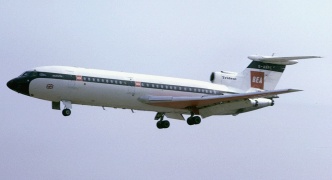
Variants
Trident 1C and 1E/1E-110/1E-140
 |
| Trident 1C, Photo: Steve Williams |
The original Trident 1C for BEA had a lower capacity and range than later models. BEA requested the DH121 design be downsized after a drop in passenger numbers which proved to be only temporary and later regretted this decision. The original Trident design features a complex nose gear bay door arrangement, Krueger flaps and leading edge droops and the APU is mounted in a pod above the central engine. The 1E and its derivatives were based on essentially the same airframe, but had a new leading edge slat arrangement, uprated engines, greater range and most importantly a higher capacity. They were principally aimed at the export market, but were sold to UK airlines BKS (later Northeast) and Channel Airways.
| Trident 1C | Trident 1E | Trident 1E-110/140 | |
| Length | 114 ft 9in | 114 ft 9in | 114 ft 9in |
| Wingspan | 89ft 10in | 95ft | 95ft |
| Engines |
3 Spey 505 @ 10,050lbs |
3 Spey 511 @ 11,400lbs | 3 Spey 511 @ 11,400lbs |
| Fuel capacity | 3,840 Imp Galls | 6,000 Imp. Galls | 6,000 Imp. Galls |
| Wing area | 1,358 sq ft | 1,407 sq ft | 1,407 sq ft |
| Cruise speed | 511 kts | 525 kts | 525 kts |
| Cruise altitude | 27,000 - 36,000 ft | 27,000 - 36,000 ft | 27,000 - 36,000 ft |
| Range | 1,150 m | 2,000 m | 2,000 m |
| Pax. capacity | 96 (typ) | 103 typ, 149 max | 103 typ, 149 max |
| MTOW | 117,300 lbs | 134,000 lbs | 135,580 lbs |

The seating capacity of the 1C was typically 96, whereas the 1E with essentially the same internal space, could be configured to accommodate 149 passengers in seven abreast layout as shown above. The original Trident wing featured Krueger flaps and a leading edge droop and short wing tips compared to the 1E and 2E. Although the wing was low drag (permitting high cruise speeds), it was necessary to fly with the droop down at speeds below 225kts IAS below 300ft as the aircraft had a relatively high stall speed. The 1E featured 3 foot wing tip extensions and the Krueger flap/droop arrangement being replaced by a more conventional leading edge slat arrangement.
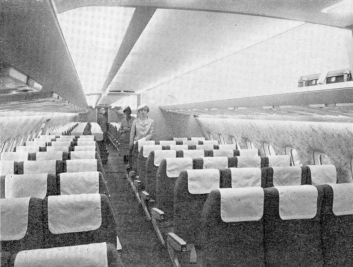 |
| Seven abreast seating in the Channel Airways Trident 1E, Neil Lomax Collection |
Trident 2E
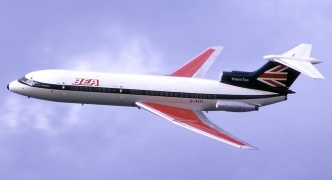 |
| Trident 2E, Photo: Steve Williams |
The Trident 2E was developed as a higher capacity, longer ranged version of the original Trident and feature an enlarged wing with new high lift devices and uprated engines. BEA and CAAC were the biggest customers, making the 2E the most built model.
| Length (overall) | 114ft 9in (34.98 m) |
| Wingspan | 98 ft (29.87 m) |
| Engines |
3 Rolls Royce Spey Mk512 @ 11,960lbs each (53.2 kN) |
| Fuel capacity | 6,400 Imperial Gallons (29,094 l) |
| Wing area | 1,493 sq. ft (138.7 m2) |
| Cruise speed | 525 kts / Mach 0.91 (604 mph / 966kph) |
| Cruise altitude | 27,000 - 36,000 ft (8,230 - 10,970 m) |
| Range | 2,400 m (3840 km) |
| Passenger capacity | 91-149 (103 typ) |
| Maximum takeoff weight | 143,500 lb (65,149 kg) |
The fuselage of the Trident 2E is virtually identical to that of the Trident 1. It features a simplified nose gear door arrangement. Accommodation is typically 103 (varied from 91 up to 149 high density, seven abreast) in six abreast seating configuration. The wings of the 2E are larger (greater area and span), than those of the previous models (1C & 1E). The leading edge droop was replaced by slats on the leading edge of the wing. The increase in area of the 2E over the 1E is marginal and is due to the revised "Kuchemann" wingtips used.
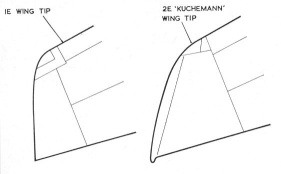
The 2E was the first to feature the Mk 512 Spey engine - the final derivative to be used on an airliner. This provided 560lb more thrust than the Mk 511 fitted to the 1E and kept the cruise speed the same despite the increase in weight of the 2E airframe over the series 1.
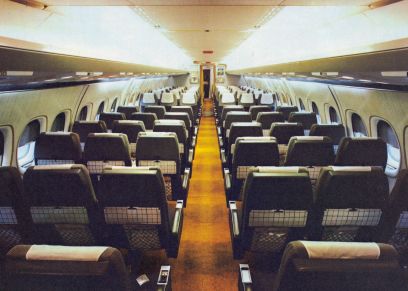 |
| Cabin of the Trident 2E, Hawker Siddeley Aviation via Neil Lomax Collection |
Trident 3B
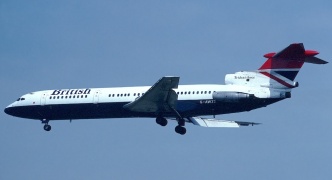 |
| Trident 3B, Photo: Johan Ljungdahl |
The Trident 3B was developed for BEA after the HS132 and HS134 and were dropped, as a cheaper solution to the requirement for an enlarged capacity airliner. The main features of this variant are the stretched fuselage and wings and the addition of the fourth engine. A subtler modification was the increase in wing incidence angle.
| Length (overall) | 131ft 2in (39.97 m) |
| Wingspan | 98 ft (29.87 m) |
| Engines |
3 Rolls Royce Spey Mk512 @ 11,960lbs each (53.2 kN) |
| Boost Engine | 1 Rolls Royce RB162 @ 5,250lbs (23.35 kN) |
| Fuel capacity | 5,620 Imperial Gallons (25548 l) |
| Wing area | 1,493 sq. ft (138.7 m2) |
| Cruise speed | 505 kts / Mach 0.88 (581 mph / 929kph) |
| Cruise altitude | 27,000 - 36,000 ft (8,230 - 10,970 m) |
| Range | 1,500 m (2400 km) |
| Passenger capacity | 180 (136 typ) |
| Maximum takeoff weight | 155,000 lb (70,370 kg) |
The Trident was originally powered by 3 Spey Mk 505 engines. Although they produced enough thrust for a high cruise speed, more power was required on takeoff, so the three Mk 512 engines used on the 2E were supplemented on the 3B with a single RB162-86, used only on takeoff. The RB162 was a development of the RB108 vertical lift engine used in the previous to decade in experimental vertical takeoff aircraft.
Trident Super 3B
Two examples of this version were built for CAAC of China. The main difference was additional fuel capacity (6,000 Imp. Gal as opposed to 5,620) which resulted in an additional range of 400 miles and an increased MTOW of 159,900 lbs.